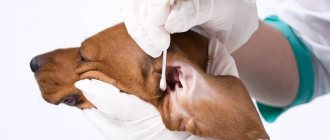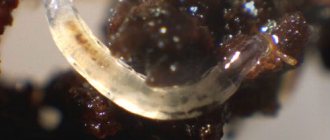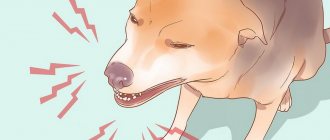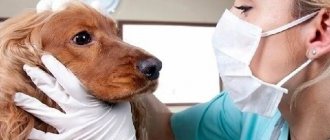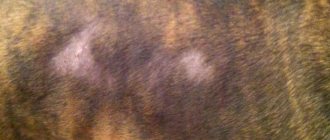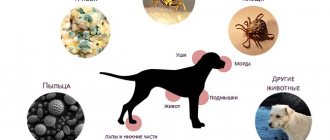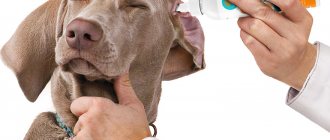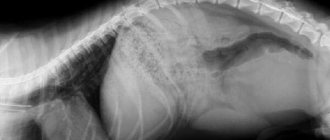Microbes, representing a significant part of the biomass of the entire planet, are the most common type of living organisms in the environment. There are not many pathogenic varieties, and under normal conditions they do not cause the development of diseases. Harmful bacteria, which includes Staphylococcus aureus, are present on the skin or in the body of even a completely healthy dog.
Causes of the disease
Staphylococcus aureus is found in both humans and dogs. Its most common habitats are the skin, mucous membranes of the upper respiratory tract and genital tract. Normally, it is suppressed by the immune system and other microorganisms.
If the body’s natural defenses against negative factors (immunity) fail, staphylococcus can cause serious infectious diseases.
There are many reasons that cause the activity of pathogenic microorganisms. For example, a pet may have come into contact with a dog that is a carrier of virulent strains, or its body may have been weakened after a long illness during which antibiotics were used for a long time. In addition, the development of pathology can be provoked by:
- operation;
- stress;
- hormonal imbalance;
- skin diseases;
- parasite bites;
- unbalanced diet;
- deficiency of vitamins and minerals;
- improper care.
The most common reason that reduces immunity in a dog is skin damage, leading to inflammation of the microflora.
It is noteworthy that if the owner of the animal himself is a carrier of Staphylococcus aureus, then in 30% of cases the pet will not be able to avoid infection.
This is especially true for small, decorative dogs, who are constantly squeezed and often even kissed.
Staphylococcal infection in dogs
Staphylococcal infection in dogs usually occurs in two forms. The first is when staphylococcus acts as a secondary infection, complicating the course of already developed dermatitis. The second is as an independent generalized disease, in which not only the skin, but also other organs are involved in the pathological process. At the same time, there is no sharp boundary between them and a secondary infection, if not treated, in a dog easily turns into a generalized form. In suckling puppies, staphylococcosis manifests itself in the form of food toxic infection.
Etiology . Staphylococci are gram-positive nonmotile aerobic or facultative anaerobic catalase-positive cocci belonging to the micrococci family. Pathogenic staphylococci differ from non-pathogenic micrococci in their ability to anaerobically ferment glucose and sensitivity to lysostaphinendopeptidase. All strains of staphylococci that produce coagulase are called aureus. Staphylococcus aureus strains generally exhibit higher biochemical activity than coagulase-negative staphylococci.
Epizootological data . Coagulase-negative staphylococci are part of the normal flora of the skin, mucous membranes and lower intestine; they are most often found in the anterior nasal passages in 70-90% of animals. They can be released for an extended period. Carriage in the nasal passages is often accompanied by secondary colonization of the skin. Violation of the integrity of skin barriers contributes to the colonization of Staphylococcus aureus.
Although staphylococci can survive in the environment for extended periods and some strains are spread by airborne transmission, transmission from one animal to another through contact is the most important route of transmission. Dogs with acute staphylococcal infection or with intense colonization, especially on the skin (burns, wounds, scratches, bedsore ulcers, bites, scratches), represent a major source of infection. Violations of aseptic and antiseptic rules by dog owners contribute to the transmission of microorganisms from one animal to another. Both Staphylococcus aureus and Staphylococcus epidermidis can cause endemic infections with large areas of skin lesions, especially when the microorganisms are multidrug resistant as a result of intensive treatment with antibacterial drugs. Upon careful examination of a sick dog, it is discovered that during the period of increased transmission of staphylococci, the skin infection becomes more active in most carriers.
Staphylococci are often isolated as causative agents of both primary and secondary bacteremia, as well as in skin and surgical wound infections.
Pathogenesis . Staphylococcal infections usually develop as a result of a combination of factors such as bacterial virulence and a decrease in the body's defenses. Important virulence factors of staphylococci include their ability to survive under unfavorable conditions, cell wall components, production of enzymes and toxins that facilitate penetration into tissues, the ability to persist intracellularly in certain phagocytes and acquire resistance to antibacterial drugs. Important protective functions of the animal's body include the integrity of the mucocutaneous barrier, a sufficient number of functional neutrophils, and the removal of foreign bodies or dead tissue.
When the integrity of the outer integument and mucous membranes is violated, the local proliferation of bacteria is accompanied by an inflammatory reaction and tissue necrosis. In such an inflamed focus, neutrophils quickly appear, capturing a large number of staphylococci. Thrombosis of adjacent capillaries occurs, fibrin is deposited along the periphery, then fibroblasts form an avascular wall around this area. A fully developed staphylococcal abscess consists of a centrally located core, destroyed and collapsing white blood cells and microorganisms that gradually melt into the characteristic thick, creamy pus surrounded by fibroplates. When the animal's defense mechanisms are unable to limit the infection to the skin or submucosal layer, staphylococci can penetrate the lymphatic system and bloodstream. Common sites of inoculation include the diaphysis of long bones, as well as the lungs, kidneys, heart valves, myocardium, liver, spleen and brain.
Multinuclear leukocytes, which have the ability for normal chemotaxis, capture and destruction of microorganisms, constitute an important element of the dog’s body’s defense mechanisms against staphylococcal infection.
Despite the fact that these infections occur in animals of any age and breed, they are severe, primarily in young and old animals, especially those suffering from chronic diseases. Primary staphylococcal pneumonia usually occurs in young animals, less often in adult dogs. Superficial staphylococcal infection in the form of pyoderma occurs more often in puppies, while abscess formation occurs mainly in adult animals.
Clinical picture . The main clinical symptom of staphylococcosis in dogs is dermatitis or also called pyoderma. Clinicians usually classify pyoderma depending on the depth of damage to the dermis and clinical symptoms. Depending on the above, clinicians divide pyoderma into superficial and shallow.
Superficial pyoderma in dogs is accompanied by damage to the upper layers of epidermal tissue and is manifested by shallow erosions, a slight exudative process and periodic itching. The affected areas of the dog are often painful.
Superficial pyoderma has two types for veterinarians. One manifests itself as acute weeping dermatitis and is called wet eczema or summer eczema, due to the fact that hot and humid weather contributes to its clinical manifestation.
With weeping dermatitis, rapidly developing skin lesions may involve the groin, dewlap, neck and tail.
In dogs, allergies (especially to fleas), obesity, and poor skin ventilation predispose them to the development of this form of dermatitis. Poor skin ventilation is especially common in dogs of long-haired breeds, and also when dog owners do not care for their dogs' skin well. Sometimes minor injuries to the skin lead to the development of this type of dermatitis.
In the absence of treatment or an inadequate response from the immune system of a sick dog, the inflammatory process can spread and invade the deeper layers of the dermis.
With shallow pyoderma, all layers of the epidermis, as well as the superficial structures of the hair follicles, are involved in the pathological process.
Shallow pyoderma in dogs can occur in two forms: impetigo, or early pustular dermatitis and superficial folliculitis.
Impetigo in affected dogs is accompanied by the appearance of pustular rashes in the groin or axillary area in dogs that have not yet reached puberty.
This type of dermatitis is sometimes discovered by dog owners by accident when caring for their dog. Dermatitis in dogs is accompanied by itching. Hormonal and immune disorders in the dog's body, endo- and ectoparasites, feeding disorders and inept care of the dog predispose to such dermatitis in dogs.
With superficial folliculitis, the superficial structures of the hair follicle are involved in the inflammatory process. As a result of inflammation, during a clinical examination of such a dog, we note hair loss and baldness of certain areas of the skin. A sick dog develops severe itching, which causes the dog to scratch and have microtraumas. In some dogs with staphylococcal infection, we record alopecia, erythema and hyperpigmentation.
In such dogs, we most often notice damage to the lower abdomen, axillary and groin areas.
With this form of skin lesions, predisposing factors are increased sensitivity to ectoparasites and disorders in the endocrine system.
Deep pyoderma in sick dogs is characterized by the involvement in the inflammatory process of not only the hair follicles and epidermal layer, but also the dermis and subcutaneous tissue. The follicular walls are usually destroyed and the dog may develop furunculous lesions.
The most common cause of this pyoderma is demodicosis, which in dogs is most often complicated by staphylococcal infection. Pyoderma can also be caused by a lack of production of thyroid hormone by the thyroid gland or an increased level of adrenocorticotropic hormone, as well as severe immunodeficiency.
Deep pyoderma in dogs can be local or generalized. The generalized form of deep pyoderma in dogs is considered by experts to be a severe skin disease and is accompanied by furunculosis, ulcerations, enlarged regional lymph nodes and abundant exudative processes. With a large area of skin affected by deep pyoderma, we note an increased body temperature in the sick dog.
Of the locally occurring deep pyoderma, the most common lesions in dogs are in the head area, folliculitis and furunculosis, interdigital folliculitis, anal furunculosis and nasal pyoderma, affecting the dorsum of the nose in dogs.
Staphylococcal infection in dogs can affect the mucous membranes of the genital organs. In bitches with staphylococcosis, staphylococcal vaginitis is diagnosed, accompanied by purulent and sometimes catarrhal discharge. If treatment is not started in a timely manner, the staphylococcal process can spread to the uterus, causing endometritis and pyometra in bitches.
When male dogs are infected with staphylococcal infection, they develop posthitis, which is clinically manifested by purulent discharge from the prepuce. If treatment is not carried out in a timely manner, the disease becomes chronic, leading to the development of proliferative processes that lead to pathological growth of epithelial tissues of the prepuce.
Staphylococcal infection in dogs can occur in the form of staphylococcal otitis. Staphylococcal otitis, depending on the intensity of the lesion, can occur hidden in dogs, causing only slight anxiety in the dog when it often shakes its head and vigorously scratches the sore ear with its paw.
During a clinical examination, by palpation of the affected ear, the veterinarian can hear the squelching sounds produced by the accumulated exudate. If appropriate therapeutic measures are not carried out, the tissues of the outer ear and the epithelium of the auricle begin to be involved in the inflammatory process. Otitis media in dogs is accompanied by swelling, redness and pain.
In some dogs, the course of staphylococcal otitis may be complicated by conjunctivitis and inflammation in some glands.
In puppies, especially in the first days of life, staphylococcal infection occurs as food poisoning. The disease in puppies begins suddenly on the 2-7th day of life and is manifested by the development of diarrhea and rapid dehydration, which leads to death in puppies. Staphylococcal diarrhea is rare in adult dogs.
Infection of the hair follicles, manifested by small erythematous nodules without involvement of the surrounding skin or deep tissues in the inflammatory process, is called folliculitis.
A more extensive and deep infection of the follicles or sebaceous glands with partial involvement of the subcutaneous tissues is called a boil.
A very extensive and deep infection of the follicles or sebaceous glands with partial involvement of the subcutaneous tissues is called a carbuncle.
Initially, itching and slight soreness appear in the affected area, then swelling and erythema intensify, and when pressing on it and when moving, the sick dog experiences acute pain. After a spontaneous breakthrough or surgical opening of the boil, the pain quickly stops and the animal calms down.
Boils most often form on areas of the body that have undergone maceration or friction due to poor hygiene, with dermatitis. Typically, boils are located in areas of the head, neck, chest, groin, tail, back, or between the toes. Staphylococcal infection can spread to the sweat glands in the armpit or groin area (hidradenitis suppurativa). In this case, deep localization of the boil is possible, its sluggish course and late breakthrough, there is a tendency to relapse and scarring.
Staphylococcal infections within the thick, inelastic skin of the neck, back, thighs, and tail are accompanied by the formation of a carbuncle. Due to the relative thickness and impermeability of the skin in dogs, the pathological process spreads in breadth with the formation of small cavities, and ultimately a large dense painful conglomerate is formed, consisting of numerous purulent, difficult-to-drainage cells. Clinically, the carbuncle is accompanied by fever, leukocytosis and severe pain. In this case, bacteremia is often recorded in a sick dog.
Diagnosis . When diagnosing staphylococcal infections, Gram-stained smears of pus are examined under a microscope, and bacteriological examination of aspirated pus, affected tissues, or sterile body fluids of the animal is also performed. In clinical materials, it is not always possible to detect a typical accumulation of bacteria; they can be located separately and in the form of identical short chains of three or four bacteria. Bacteria in the resting phase or inside white blood cells may be gram-negative. Large numbers of neutrophils are usually detected, many of which contain bacteria, except in dogs with severe neutropenia.
Therapeutic measures . Treatment of dogs with staphylococcal infection should be carried out comprehensively. Both local and general therapy are used in treatment.
Specific immunotherapy . The use of specific immunotherapy in the treatment of staphylococcosis in dogs is the most effective method of treatment. Specific immunotherapy can be either active or passive. When using active immunotherapy, veterinary specialists use a variety of industrially produced staphylococcal toxoids and antigens. When they are used in the dog’s body, the immune defense reaction is activated.
When treating staphylococcosis in dogs, veterinary specialists use ASP (polyvalent staphylococcal toxoid). For passive immunization, antistaphylococcal hyperimmune sera and immunoglobulin preparations are used. It is better to use these medications in the early stages of the disease and when staphylococcal lesions are limited in nature.
Nonspecific immunotherapy . Considering that with staphylococcal infection in dogs, the immune response in the body is suppressed, veterinary specialists at clinics resort to the use of immunostimulants. In this case, it is necessary to proceed from the fact that the most effective treatment is stimulation of the cellular component of immunity (T cells and phagocytes).
Antibiotic therapy . Considering the rapid “addiction” of the causative agent of staphylococcosis to antibiotics, when treating sick dogs it is necessary to use only antibiotics titrated in a veterinary laboratory. At the present stage of treatment of staphylococcal infections, the most effective against staphylococci are antibiotics of the quinolone group (Baytril, Cyflox, Enroxil). The therapeutic effectiveness of the antibiotics used can be significantly increased if they are used in combination, using 2-3 antibiotics simultaneously during treatment.
Bacteriophage. When treating dogs with staphyloccal infection, you can use a bacteriophage produced by the medical industry.
Pathogenetic and symptomatic therapy.
When treating staphylococcal infections, veterinary specialists use local therapy, which is aimed at reducing the number of pathogens in the pathological focus. When carrying out local treatment, veterinary specialists use:
- enzymatic preparations of lysozyme, chemotrypsin and other solutions of these drugs irrigate ulcers, erosions, and also wash the vagina and prepuce cavity;
- antibiotics;
- drying and cauterizing preparations - 2% solution of protargol, solution of potassium alum, tannin or dermatol;
- drugs and methods that reduce the number of pathogens in the pathological focus (sorbents, disinfectants, etc.).
Veterinary specialists use Tribasc and chlorophyllint as effective antistaphylococcal drugs.
For severe itching in sick dogs, it is necessary to use novocaine applications or wash the lesion with dimexide solutions.
If the itching of a sick dog is of allergic origin, then the sick dog must be prescribed antihistamines (pipolfen, suprastin, tavegil, etc.).
When treating staphylococcal otitis, the therapy used in the treatment of otitis in dogs is used. Good results are obtained by injecting a powder consisting of a mixture of dermatol and novocaine into the ear canal. In acute cases, a good therapeutic effect is obtained from the use of novocaine blockade with local antibiotic therapy.
When treating posthitis and vaginitis, more attention should be paid to washing the vagina and prepuce with antimicrobial drugs. If there is pathological tissue growth, it is necessary to use cauterizing drugs in treatment - protargol, lapis, etc.
When treating staphylococcal enteritis, the dog is prescribed chlorophyllept, antibiotics and other antimicrobial agents orally. The use of probiotics (bifidumbacterin, lactobacterin, etc.) gives good results.
In order to stabilize cell membranes in the body of a sick dog, a 10% solution of calcium chloride and calcium gluconate are widely used.
Calcium chloride preparations have a good therapeutic effect on the course of immunological reactions and lead to a decrease in allergenicity in the body of a sick dog.
Vitamin therapy is widely used in treatment. Vitamins A and E are especially widely used, as well as group B and ascorbic acid.
To neutralize predisposing factors it is recommended:
- To reduce blood sugar levels, use antidiabetic drugs (insulin, etc.).
- In case of dysfunction of the thyroid gland - thyroidin, thyrotropin, L-thyroxine.
- For allergies, in order to reduce the toxic effects of inflammatory mediators on the dog's body, antihistamines (suprastin, diphenhydramine, tavegil) are used, and measures are also taken to eliminate the causes of allergies - the destruction of ecto- and endoparasites and household allergens.
When carrying out treatment, it is necessary to remember the existing contraindications for the treatment of staphyloccosis in dogs:
- toxoid and antisera cannot be used simultaneously;
- Be very careful when using corticosteroids.
Measures to combat outbreaks of infection consist of quickly identifying sick dogs that serve as its reservoir. For this purpose, a bacteriological examination of the contents of wounds, nasal discharge and material obtained from the groin and perineum area is carried out. Urine samples for culture should be collected using an indwelling catheter. Isolating dogs with positive culture results reduces the possibility of infection spreading. Cleaning the room in which an infected, sick dog is located should be done using phenolic preparations.
Despite the fact that carriers of microorganisms in the nasal passages can serve as a source of infection, its spread most often occurs from patients with skin diseases (eczema, allergic dermatitis, dermatoses, scabies), easily complicated by colonization with Staphylococcus aureus. They should be isolated and investigated until negative laboratory results are obtained, or active therapy should be administered.
It is necessary to clean the skin and nasal cavity of sick animals by washing the entire body using antiseptic soap (tar, baby), the deposits of which on the skin inhibit the development of microflora.
To prevent staphylococcal infection, dogs are immunized. The drug ASP is used for immunization. To prevent staphylococcosis in newborn puppies, it is necessary to vaccinate bitches with TSA on the 20th and 40th days of pregnancy.
Prevention of staphylococcosis in dogs should include:
- elimination of factors that predispose to this disease;
- observe the rules of hygiene, keeping and feeding dogs;
- do not allow your dogs (especially sexual ones) to come into contact with animals sick with staphylococcosis.
Main symptoms
Staphylococcus aureus can easily be confused with some other disease. Most often it is disguised as dermatitis. The owner should be alert to the following symptoms:
- fever of a constant or intermittent type;
- vomiting and diarrhea leading to dehydration (in the intestinal form);
- inflammation, swelling around damaged skin;
- discharge of purulent exudate from the wound;
- matted fur and hair loss;
- itching;
- damage to mucous membranes;
- unpleasant odor from the skin and ears;
- slow healing of wounds.
In some cases, the wounds turn into boils or poorly healing, very painful ulcers. As the infection progresses, the animal’s condition worsens, which is why it is so important to show your pet to a specialist in a timely manner.
How is the treatment carried out?
When a diagnosis is made at the first manifestations of the disease, the effectiveness of drug treatment increases. Because staphylococcus is treated much faster in the first stages. How to cure staphylococcus in a dog? Before starting treatment, you need to examine the dog. Diagnostics include:
- examination by a doctor;
- smear analysis;
- mandatory checking of the dog for allergies, as well as diseases related to immunity;
- scraping from a wound on the animal's body.
If sick, your veterinarian may prescribe antihistamines to relieve the irritation. The dog will itch and may scratch the wounds, thereby causing infection. If such therapy is not carried out, the entire course will drag on for a long time. Doctors often prescribe Chlorophyllin-OZ for itching. Dimexide liquid can be used to wash wounds.
The use of substances specifically designed for washing will help eliminate staphylococcus in dogs. These are ointments, gels with a bactericidal result. To dry the area of inflammation, you can use a well-known remedy - zinc paste.
Staphylococcus aureus in a dog must be treated with strong substances that have a detrimental effect on the bacteria. Therapy can last up to three weeks. If the form of the disease is advanced, then taking medications continues for two weeks. Naturally, the treatment of disease in dogs is carried out according to the characteristics of the animal’s body. However, there are groups of medications that the veterinarian often prescribes:
- Antibiotics. Category quinolones, a group of synthetic antimicrobial drugs that have a bactericidal effect. These medications include: Renrovet, Enroflon, Ofloxacin.
- Medicines that stimulate the immune system. Positive results are provided by treatment when, after taking medications, the body more quickly counteracts the disease. For this purpose, the staphylococcal vaccine Antifagin is used, but it is not effective against all types of microorganisms. Staphylococcal polyvalent anatoxin (STA) is considered effective and is intended for the treatment and prevention of disease in dogs. When prescribing antibiotics for an animal, as well as substances to improve the immune system, the doctor always assumes that the drugs can cause addiction. To prevent this phenomenon, it is necessary to change the medicine.
- Injection of staphylococcal bacteriophage. A drug that has a bactericidal effect against strains of staphylococci. The medicine does not affect other bacteria and does not disrupt the natural microflora. A bacteriophage is considered a virus that promotes the death of infectious agents. This method is considered effective. To achieve the maximum therapeutic effect, treatment should begin as soon as possible after the onset of symptoms of the disease.
Please note that no matter what treatment options are available, you must first consult a doctor. Only a veterinarian can prescribe the medication that is appropriate for your dog and determine the exact dosage.
Preventive action
The main thing that needs to be done to prevent infection is to consult a doctor and carry out the necessary tests to confirm the diagnosis. Dogs infected with staphylococcus bacteria are immediately isolated from other animals and from contact with people. In a house where a dog lives, the premises must be disinfected daily. For preventive purposes, immunization with injection of the ASP vaccine is indicated.
To reduce the threat of staphylococcus disease in dogs to a minimum, you should monitor your pet’s diet; it must contain enough vitamins. During the mating period, you need to carefully choose a candidate for your dog, since any infections can be transmitted to your animal. It would be a good idea to use anti-parasite collars; they can protect your dog from getting fleas and ticks on his body.
After an illness, re-infection may occur. When an animal has many folds on its skin, you should carefully monitor their cleanliness, because dirt and sweat collect in the folds. And this can lead to re-infection. When an animal is injured during a walk, the scratch should be treated with antiseptic substances.
There is no need to view a staph infection as a common disease that is easy to deal with. Most dog owners are unaware of the dangers of contracting staphylococcus bacteria. Therefore, they do not pay attention to the symptoms of the disease in dogs. After all, preventing the formation of an infection is much easier than treating it for several months.
Take care of your dog; when the first signs of dangerous diseases appear, you should immediately consult a veterinarian. It’s true that a diagnosis and properly prescribed medications will help cope with diseases and cure them in the early stages of manifestation.
Diagnostics in a veterinary clinic
To detect pathogenic microorganisms, the veterinarian will need to conduct a number of diagnostic tests, in addition to a visual examination and medical history. These include:
- taking a smear from the loop and prepuce;
- examination of scrapings from ulcers on the animal’s body;
- test for allergic reactions and immune diseases.
Next, tests are required to determine the sensitivity of the strain to antibiotics. This is a necessary measure to allow the doctor to prescribe adequate treatment.
A blood test cannot confirm or deny the presence of infection in a dog’s body, so this type of research is not practical.
Possible complications
Possible complications of staph infections in dogs include the development of antibiotic resistance. Unfortunately, there is currently a worldwide trend towards the widespread spread of multi-resistant staphylococcus, that is, resistant to conventional antibiotics. As a result of research, it has been proven that dogs infected with such staphylococcus can secrete multidrug-resistant staphylococcus for a whole year after recovery, so such pets should be considered as a potential source of the spread of this dangerous infection.
Treatment method and prognosis
Treatment of Staphylococcus aureus is complex. You need to understand that this is a long process that requires a lot of patience from the owner. A course of antibiotics is required, sometimes several drugs with different spectrums of action. They are selected individually, based on the results of testing for the sensitivity of the strain.
The dosage is determined by the veterinarian. For example, when prescribing Ceftriaxone, it is at least 40 mg per 1 kilogram of weight. The duration of the course is 5 days. If during this time the dog’s condition has not improved, it is advisable to replace the drug.
In addition, immunostimulants, bacteriophages, hepatoprotectors (to protect the liver), antihistamines, as well as drugs containing antibodies to harmful microorganisms are indicated.
Damage to the skin and mucous membranes is treated with disinfectants (hydrogen peroxide, protargol solution, aluminum alum, etc.), after which antimicrobial drugs that eliminate itching and wound-healing ointments are applied to the treated surfaces. If an abscess forms on the skin, it is opened surgically, dead and damaged tissue is excised and drained.
Therapy, which lasts from 3 to 6 weeks, cannot be interrupted without the permission of the veterinarian. The disappearance of clinical signs does not mean that the pathology has been overcome. This is just a period when the disease recedes. After treatment, repeat tests are done.
As for the prognosis, Staphylococcus aureus cannot be cured completely, since the pathogen is constantly in the animal’s body. However, treatment prevents the possibility of relapse and deterioration of the pet’s condition under the influence of pathogenic microorganisms.
Prevention of staphylococcus
- The most effective method of prevention is timely vaccination. Puppies are vaccinated at 20-40 days, adult dogs – once a year.
- In addition to mandatory vaccinations, it is very important to maintain your pet’s immunity. It is important to monitor your dog’s diet - in addition to good dry food or meat, your dog’s diet must include vegetables. According to indications, it is necessary to carry out a course of vitamin therapy (necessarily on the recommendation of a veterinarian, otherwise you can only harm the dog).
- The owner of the animal must carefully monitor the condition of the pet's coat and skin, especially in dog breeds with many folds on the skin - it is in the folds that pathogenic microorganisms multiply.
- When walking, it is advisable to avoid contact with sick animals.
Staphylococcal infection is a dangerous disease that can lead to irreversible changes in internal organs and death of the animal, so it is very important to start treatment on time and not skip taking prescribed medications.
It is important to remember that staphylococcal infection is curable, but prevention and hygiene measures must also be observed so that the dog can please its owner with health and beauty for a long time.
4.7 / 5 ( 23 voices)
What to do at home
The dog owner must strictly follow the veterinarian's instructions. In addition, we must not forget that Staphylococcus aureus can be transmitted to humans, so when caring for a sick pet, you must take the necessary precautions:
- Wash your hands with laundry soap, using a brush to treat the area under the nail plates.
- Use disposable medical gloves. After handling the dog, they must be thrown away.
- Isolate the sick animal from other family members and pets.
- Collect and destroy dog feces by burning.
- Disinfect the room where the pet is located, its toys, bedding, etc. It is better to burn things that are not of great value.
A sick dog should receive a complete, balanced diet, enriched with vitamins and macroelements. If the animal experiences vomiting and diarrhea, gastric lavage and cleansing enemas are performed. A fasting diet is indicated - at least 12 hours.
Since the body is exhausted, parenteral nutrition is performed. During the recovery period, low-fat broths and water porridges are gradually introduced. Products should be introduced into the diet gradually, feeding in small portions.
Folk remedies for treating staphylococcus
Home treatment for staph infection is not as effective as traditional therapy, but the following methods can be used to relieve symptoms and maintain your dog's condition:
- Adding apple cider vinegar and herbal decoction to bathing water.
- Washing with tar soap.
- Wound surfaces can be washed with burdock decoction.
When conducting traditional therapy, such methods of home care for a pet can enhance the effectiveness of treatment prescribed by a veterinarian.
Characteristics and features of the microorganism
Staphylococci belong to a group of organisms that includes thousands of subspecies and are shaped like a bunch of grapes. These bacteria surround people and animals in everyday life. Since staphylococci exist almost everywhere, they can greatly affect the weakened body of animals, especially dogs. In the summer, the risk of developing a staphylococcus infection increases, since the pet walks a lot and often comes into contact with other individuals. Animals kept in ideal conditions are also susceptible to the influence of this microorganism.
Risk group and routes of transmission
The following dogs are at risk:
- With diabetes
- With a lack of vitamins in the body
- Infested with ticks, fleas
- Allergy sufferers
- With a weakened immune system
- Elderly and small puppies
Staphylococcus is transmitted between dogs; the risk of infection is higher if the pet has a weakened immune system.
The disease is transmitted between immunocompromised dogs
